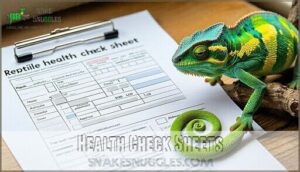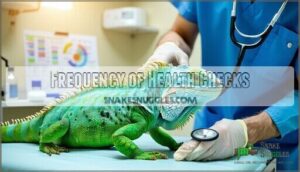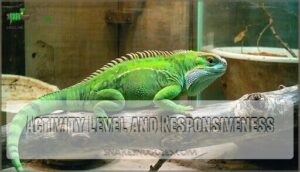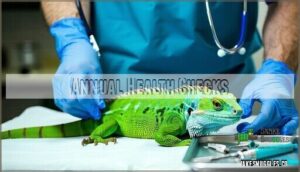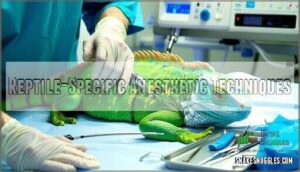This site is supported by our readers. We may earn a commission, at no cost to you, if you purchase through links.

Check your pet’s activity level, responsiveness, and alertness – healthy reptiles show consistent patterns you’ll recognize over time.
Examine their gait, body shape, appetite, and waste output regularly.
Look for changes in skin color, texture, or shedding patterns that might indicate health issues.
Pay attention to their normal routines, since reptiles are creatures of habit.
Document any unusual behaviors, eating changes, or physical abnormalities.
Regular monitoring helps you catch problems early, when treatment is most effective and less stressful for your scaly companion, and it allows for early detection of potential problems, ensuring the best outcome for your pet, through consistent monitoring and prompt action.
Table Of Contents
- Key Takeaways
- Reptile Health Checks
- Health Check Sheets
- Frequency of Health Checks
- Reptile Health Indicators
- Veterinary Care and Procedures
- Preventive Care and Husbandry
- Owner Responsibilities and Safety
- Frequently Asked Questions (FAQs)
- What are the signs of ill health to look for when obtaining a reptile?
- How often should reptiles go to the vet?
- What is the most common nutritional problem seen in reptiles?
- What specific blood tests should reptiles receive annually?
- How do you safely transport reptiles to veterinarians?
- Which common household items are toxic to reptiles?
- What vaccinations do pet reptiles typically need?
- How much does reptile veterinary care usually cost?
- Conclusion
Key Takeaways
- You’ll catch health problems early by conducting monthly physical exams that check your reptile’s skin condition, eye clarity, body weight, and movement patterns before issues become serious emergencies.
- You need to monitor daily behaviors like appetite, activity levels, and responsiveness since reptiles are creatures of habit, and any changes from their normal routine often signal underlying health concerns.
- You should create and maintain health tracking sheets to document weight changes, feeding patterns, and behavioral observations over time, making it easier to spot trends and share accurate information with your veterinarian.
- You must establish proper husbandry practices including correct temperature gradients, humidity levels, UVB lighting, and regular sanitation to prevent most common reptile health problems before they start.
Reptile Health Checks
Regular health checks help you catch problems early before they become serious, expensive issues.
You’ll want to examine your reptile’s physical appearance, monitor their eating habits, and watch for changes in behavior that could signal trouble.
Physical Appearance
Your reptile’s physical appearance serves as the first line of defense in detecting health issues before they become serious problems.
Start with a systematic visual inspection during each reptile health check to spot early signs of illness.
A thorough visual exam catches health problems before they escalate into expensive emergencies.
- Skin Condition and Scale Integrity – Examine for wounds, swelling, discoloration, or abnormal shedding patterns that indicate infection or parasites.
- Eye Clarity and Limb Symmetry – Check for cloudy eyes, discharge, or uneven limb positioning that suggests injury or neurological issues.
- Vent Examination – Inspect the vent area for swelling, discharge, or prolapse, which are common reptile symptoms requiring immediate attention.
Appetite and Digestion
Food refusal signals potential health issues, so monitor your reptile’s appetite closely during each health check.
Watch stool consistency, hydration levels, and note any regurgitation signs, as these reveal digestive problems.
Ensuring proper reptile food variety is essential for their well-being.
Understanding your pet’s specific dietary needs helps you spot when something’s off with their feeding patterns, which is crucial for maintaining their overall health.
Behavior and Activity Level
Beyond eating habits, your reptile’s behavior and activity level reveal important health information that you shouldn’t overlook.
Changes in normal patterns often signal underlying problems before physical symptoms appear.
Your reptile’s subtle shifts in routine often reveal health problems long before visible symptoms emerge.
- Lethargy signs – Unusual sluggishness, reduced movement, or extended periods of inactivity
- Abnormal behaviors – Repetitive motions, disorientation, or aggressive responses to normal stimuli
- Responsiveness cues – Delayed reactions to handling, feeding, or environmental changes
- Hiding behavior – Excessive retreating or stress indicators like rapid breathing
Health Check Sheets
Health check sheets provide a systematic way to track your reptile’s condition over time, making it easier to spot patterns or changes that might indicate health issues.
You can find pre-made templates online or create custom sheets using spreadsheet programs to match your specific reptile’s needs.
Creating Custom Sheets
You’ll find health check sheets online and at pet stores, but creating your own template guarantees it matches your reptile’s specific needs.
Design your digital tracking system using spreadsheet programs like Excel or Google Sheets, organizing data into clear categories for health monitoring.
Consider using an Excel reptile sheet for a pre-made template.
Customize sections based on your species’ requirements—bearded dragons need different tracking than ball pythons—and make sharing sheets easy for veterinary visits with a clear and digital tracking system.
Tracking Health Trends
By monitoring your reptile consistently, you’ll discover patterns that speak volumes about their well-being.
Weight fluctuations and shedding frequency become your roadmap to understanding what’s normal versus concerning. Detecting issues early is possible with snake parasite health checks.
- Weight tracking – Record measurements monthly to catch gradual changes that signal health shifts
- Behavioral patterns – Note activity levels, feeding habits, and hydration patterns for baseline comparisons
- Appetite documentation – Track feeding responses and behavioral changes to identify early warning signs
Identifying Potential Issues
Once you’ve tracked health trends, early detection becomes your next priority.
Skin abnormalities, weight fluctuations, and behavioral changes often signal developing health issues before they become serious problems.
Watch for digestive signs like irregular stool or reduced appetite.
| Warning Sign | What to Look For | Action Needed |
|---|---|---|
| Behavioral changes | Lethargy, hiding, aggression | Monitor closely, vet if persistent |
| Skin abnormalities | Stuck shed, discoloration, lesions | Check humidity, seek treatment |
| Weight fluctuations | Rapid loss or gain | Adjust feeding, veterinary exam |
| Digestive signs | Diarrhea, constipation, vomiting | Review diet, immediate vet care |
| Respiratory symptoms | Mouth breathing, wheezing | Emergency veterinary attention |
Regular observation helps you spot abnormal behavior patterns that might otherwise go unnoticed until advanced stages, which is crucial for early detection and taking the right action needed to prevent serious health issues, including those related to digestive signs and respiratory symptoms, and it requires monitoring for behavioral changes and skin abnormalities.
Frequency of Health Checks
You’ll need to monitor your reptile’s health consistently to catch problems before they become serious.
Most reptiles should receive health checks at least monthly, though weekly examinations work better for young animals, newly acquired pets, or species with known health risks.
Monthly Checks
Establishing a monthly reptile health check routine helps you catch problems before they become serious.
You’ll develop stronger observation skills while building a thorough health record that veterinarians find invaluable for treatment decisions.
- Schedule consistent monthly examinations to track weight changes, skin condition, and overall body condition using your customized health check sheet.
- Document all findings thoroughly including appetite patterns, behavioral changes, and environmental conditions to support early detection of health issues.
- Review previous month’s data to identify trends or gradual changes that might indicate developing health concerns requiring professional attention.
Be alert for unusual shedding patterns that may indicate parasitic issues.
Weekly Checks for High-Risk Species
Some reptiles require weekly health checks due to Species Susceptibility to rapid health changes.
Young reptiles, recently acquired animals under Quarantine Protocols, and species prone to stress need closer Enclosure Monitoring.
Weekly reptile health check sessions allow better Hydration Assessment and Injury Prevention through consistent reptile behavior observation, ensuring ideal reptile care and timely reptile veterinary care interventions.
Immediate Action for Abnormal Findings
When health irregularities appear during your routine checks, swift action protects your reptile’s well-being and prevents minor issues from becoming serious complications.
Document observations immediately, then contact your reptile vet for guidance on necessary steps.
- Veterinarian Consultation – Call your reptile vet within 24 hours when you notice behavior changes or signs of illness
- Isolate Reptile – Separate sick animals from tank mates to prevent disease spread and reduce stress
- Document Observations – Record specific symptoms, timing, and environmental conditions for accurate veterinary assessment
- Housing Adjustments – Modify temperature, humidity, or lighting based on your vet’s recommendations for recovery
- Medication Administration – Follow prescribed treatment schedules precisely, ensuring proper dosage and delivery methods
Reptile Health Indicators
Knowing what normal looks like for your reptile helps you spot problems before they become serious health issues.
You’ll want to monitor key indicators like activity levels, movement patterns, and body condition during each health check.
Activity Level and Responsiveness
Your reptile’s activity level and responsiveness serve as reliable windows into their overall health during your reptile health check.
Watch for lethargy signs like reduced movement or unusual hiding behaviors that persist beyond normal patterns.
Disorientation causes concern when your pet appears confused or unsteady, and testing their responsiveness by gently approaching can help identify potential issues.
Healthy reptiles typically react with awareness, while reduced engagement may signal underlying issues requiring immediate observation and potential veterinary consultation.
Gait and Movement
Observing how your reptile moves reveals important clues about their physical condition.
Watch for limping causes like injuries or infections, muscle atrophy from poor nutrition, spinal issues affecting coordination, and movement symmetry problems.
A thorough reptile health check includes analyzing gait patterns during your reptile examination.
- Symmetrical movement patterns – Both sides of your reptile’s body should move evenly without favoring one side over another
- Smooth coordination – Limbs should work together seamlessly without jerky or uncontrolled movements that suggest neurological problems
- Normal stride length – Steps should be consistent and appropriate for your reptile’s size, not shortened due to pain or weakness
Body Shape and Weight
Monitoring your reptile’s body shape and weight reveals essential health information that movement patterns can’t always show.
You’ll want to assess ideal proportions for your specific species, checking for muscle tone and skeletal structure abnormalities.
Watch for organ enlargement, which may indicate serious conditions, and evaluate hydration levels through skin elasticity.
Regular reptile weight management through consistent body shape analysis helps catch issues early during your reptile health check routine, ensuring reptile health.
Veterinary Care and Procedures
While you can monitor your reptile’s health at home, professional veterinary care remains essential for thorough health assessment and treatment.
Reptile-experienced veterinarians use specialized techniques like chemical restraint and species-specific anesthesia to safely examine and treat your scaly companion when needed, utilizing professional veterinary care for the best outcomes.
Annual Health Checks
While you might think your pet is fine between visits, annual health checks create the foundation for spotting problems before they become serious.
Your reptile vet establishes baseline comparisons during these preventative screenings, tracking everything from weight changes to subtle behavioral shifts that reveal husbandry impact on long-term health.
Regular screenings should also include snake parasite health to facilitate early detection.
- Veterinarian Selection: Choose specialists experienced with your specific species
- Preventative Screenings: Include blood work, fecal exams, and parasite testing
- Baseline Comparisons: Document normal ranges for future health assessments
Chemical Restraint and Sedation
When your reptile won’t cooperate during examinations, chemical restraint becomes necessary for everyone’s safety.
Sedation protocols using agents like midazolam or ketamine require careful dosage calculation based on species and weight.
Temperature control during anesthesia is critical since reptiles can’t regulate body heat.
Postoperative support includes analgesia and fluid therapy to help reptiles recover comfortably.
Recovery monitoring guarantees your pet awakens safely, watching for drug interactions and anesthesia risks throughout the process.
Reptile-Specific Anesthetic Techniques
Three critical factors shape reptile anesthesia success.
Drug selection varies substantially between species, with chelonians requiring different protocols than snakes.
Intravenous propofol offers rapid, controlled induction, while intramuscular ketamine combinations work well for chemical restraint.
Monitoring protocols must track heart rate using Doppler devices since traditional methods fail.
Optimal temperature ranges are essential for bodily function.
Recovery strategies demand maintaining proper temperatures throughout, as hypothermia dangerously prolongs drug effects and compromises patient safety.
Preventive Care and Husbandry
Prevention is your best defense against reptile health problems, starting with consistent husbandry practices that maintain proper sanitation, nutrition, and environmental conditions.
You’ll create the foundation for long-term health by establishing appropriate temperature gradients, humidity levels, and UVB lighting while implementing regular parasite screenings and disease prevention protocols.
Proper Sanitation and Nutrition
Proper sanitation and nutrition form the foundation of reptile health, preventing most common illnesses before they start.
Clean your reptile’s enclosure weekly, removing waste and uneaten food to maintain water quality and prevent bacterial growth. Provide diet variety with species-appropriate foods, ensuring supplementation needs are met through calcium and vitamin D3.
Monitor feeding habits closely for obesity prevention, as overweight reptiles face serious health risks. Fresh, dechlorinated water should always be available, with regular water changes maintaining superior hygiene standards.
Environmental Conditions and UVB Lighting
Creating the right environmental conditions transforms your reptile enclosure into a thriving habitat.
Temperature gradients let your reptile thermoregulate naturally, while proper humidity levels support respiratory health and successful shedding.
UVB lighting intensity and duration directly impact calcium absorption and overall reptile health. Proper lighting guarantees essential UVB wavelengths for reptile well-being.
Monitor these environmental conditions carefully, as proper enclosure size allows for necessary temperature variations that keep your pet comfortable and healthy.
Preventive Screenings for Parasites and Diseases
Beyond regular observation, fecal exams every 6-12 months detect hidden parasites that affect up to 31% of captive reptiles.
Blood testing and quarantine protocols for new arrivals prevent disease transmission.
Early detection through preventive screenings helps your reptile vet identify issues before symptoms appear, making disease prevention far more effective than treating advanced reptile illness.
Owner Responsibilities and Safety
As a reptile owner, you’re responsible for recognizing warning signs like lethargy, loss of appetite, or unusual behaviors that signal health problems.
You must also learn proper handling techniques and understand potential risks from zoonotic diseases or venomous species to keep both you and your pet safe.
Recognizing Abnormal Behaviors
Why does your reptile suddenly act differently from its usual routine?
Lethargy signs, hiding excessively, erratic movements, refusal feeding, and basking avoidance signal potential health concerns that require immediate attention.
Understanding reptile behavior knowledge helps you distinguish between normal activities and abnormal behavior indicators.
Stress indicators like irritability or unusual hiding behavior often appear before visible symptoms.
Recognizing these issues early can be vital, especially when recognizing snake neurological issues.
Monitor these patterns closely, as early recognition prevents minor issues from becoming serious health problems requiring emergency veterinary intervention.
Proper Handling Techniques
Handling your reptile correctly protects both you and your pet during reptile health checks.
Safe restraint techniques vary by species, so understanding your reptile’s anatomy and behavior helps prevent injury.
- Support the body properly – Use gentle, firm grip behind the head for snakes; support torso and hindquarters for lizards
- Move slowly and confidently – Quick movements trigger defensive responses and increase bite risk
- Recognize stress signals – Heavy breathing, color changes, or aggressive posturing mean it’s time to pause
- Practice regular handling – Frequent, brief sessions build trust and reduce anxiety during actual health examinations
Zoonotic Diseases and Venomous Reptiles
Protecting yourself from zoonotic diseases and venomous reptiles requires constant vigilance and proper protocols.
An estimated 70,000 Americans contract Salmonella transmission annually from reptiles, while venom potency varies dramatically between species.
Understanding reptile toxins and implementing bite prevention strategies protects both you and your family from serious health complications.
| Risk Category | Prevention Strategy |
|---|---|
| Salmonella Transmission | Wash hands thoroughly after handling |
| Venomous Reptiles | Use proper restraint equipment |
| Zoonotic Risks | Avoid food preparation areas |
| Reptile Toxins | Seek immediate medical attention |
| Bite Prevention | Never handle without supervision |
Frequently Asked Questions (FAQs)
What are the signs of ill health to look for when obtaining a reptile?
Don’t put all your eggs in one basket when selecting reptiles.
Look for clear, bright eyes, alertness, proper body weight, clean skin without lesions, normal breathing patterns, and active movement during appropriate times.
How often should reptiles go to the vet?
You should schedule annual veterinary visits for your reptile, with additional checkups if health concerns arise. Monthly home health checks help you monitor between professional exams and catch issues early.
What is the most common nutritional problem seen in reptiles?
Over 80% of reptile health problems stem from poor nutrition, making metabolic bone disease the most common issue you’ll encounter.
You’ll typically see this devastating condition when calcium deficiency weakens bones and causes deformities in your pet, leading to metabolic bone disease.
What specific blood tests should reptiles receive annually?
You’ll want to request a complete blood panel including protein levels, liver enzymes, kidney function markers, and blood glucose.
Your vet might also recommend checking calcium, phosphorus, and vitamin levels to confirm proper metabolic health.
How do you safely transport reptiles to veterinarians?
Use a secure, well-ventilated carrier that’s appropriately sized. Line it with paper towels, maintain proper temperature during transport, and minimize handling stress by keeping the journey quiet and smooth.
Which common household items are toxic to reptiles?
Your home harbors silent dangers lurking where you’d least expect them.
Cleaning products, air fresheners, scented candles, cedar shavings, and mothballs release toxic fumes that can poison your reptile’s sensitive respiratory system through everyday exposure.
They can cause harm through everyday exposure.
What vaccinations do pet reptiles typically need?
Unlike dogs and cats, pet reptiles don’t require routine vaccinations.
There aren’t any approved vaccines for common reptile species like snakes, lizards, or turtles.
Instead, you’ll focus on preventive care through proper husbandry, nutrition, and regular veterinary checkups to ensure the health and well-being of your pet reptiles, which is a key aspect of proper husbandry.
How much does reptile veterinary care usually cost?
Wondering what you’ll spend on reptile vet bills?
Expect $75-200 for routine exams, $150-500 for diagnostic tests.
And $300-1,000+ for surgeries or emergency treatments depending on your reptile’s species and condition.
Conclusion
Mastering your reptile health check guide transforms you from a worried owner into a confident caretaker who spots problems before they become serious.
Regular monitoring creates a baseline of normal behaviors, making abnormalities stand out clearly. You’ll develop an eye for subtle changes that indicate illness, injury, or stress in your scaly companion.
This systematic approach guarantees your reptile receives timely veterinary care when needed, preventing minor issues from escalating into life-threatening emergencies that require expensive treatment, ensuring your pet gets the proper care and attention to prevent serious health issues, and ultimately leading to a better quality of life for your scaly companion.
- https://showmereptileshow.com/resources/a-guide-to-identifying-healthy-reptiles-before-purchasing
- https://allcreaturesbremerton.com/how-do-i-know-if-my-reptile-is-sick/
- https://thewebinarvet.com/blog/ensuring-quality-of-life-in-older-reptiles-a-comprehensive-guide
- https://vcahospitals.com/know-your-pet/veterinary-care-new-reptile-visit
- https://www.highlandvet.net/preventative-healthcare-plans/reptile

